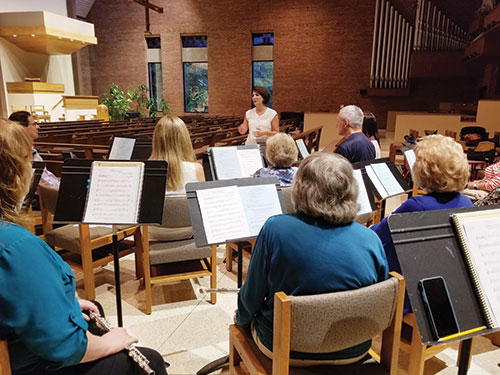Recent Trends
The birthrate has declined steadily which means there are fewer students. In addition, private lessons may have become out of reach for many families during recent economic downturns. Another change is the focus on STEM classes (science, technology, engineering and math). In many schools a STEM curriculum is emphasized at the expense of fine arts classes. Despite extensive evidence showing that music students excel in their other classes, parents may not be aware of this. As a result, when it comes to taking private lessons, many select computer camps, sports, or exam prep classes to help their children prepare for college.
Overscheduling is another pervasive problem as students are involved in too many activities and have no time to practice. With both parents working, getting students to music lessons and encouraging them to practice may feel like one thing too many.
An elementary music teacher recently told me that flute is perceived as being too hard to learn. She is an excellent teacher and flutist and had no idea why this perception prevailed. I asked what the most popular instrument is, and she replied saxophone.
Some Solutions
Marketing yourself effectively today means an online presence. Make sure that you have a clear, simple website. I have noticed that the more famous the flutist, the simpler and more direct his or her website is. Ask friends to look at your site and see how easy it is to navigate. Often what seems obvious to you is confusing to the parent of a potential student.
Be cautious about signing on to money-making programs on the internet, including those that promise an increase in traffic to your web page. Don’t spend money until you are making money. Go to the public library and check out books on marketing. Make business cards.
Assess the market. Consider adding the option of giving lessons in students’ homes for an additional fee. This is popular in high population areas, especially when both parents work. Check out the possibilities of giving lessons at schools and music stores.
Contact local band and orchestra directors and offer to give a free masterclass. Prepare a handout of fun, informative warmups to teach. On the handout include your name and contact information. If students feel they learned a lot in your class, they will call. When selecting material to teach, remember that students are action oriented so they will enjoy playing more than hearing you talk or perform.
To combat the idea that the flute is too hard or practicing is boring, strive to make these classes fun and work on things that students can achieve in this short period to feel successful. You could also offer basic classes at the elementary school level to introduce students to the instrument and drum up interest for the future.
Get together with other local teachers, both private and in the schools, as well as parent groups to advocate for the benefits of music education. There is a growing push to add an A (for Arts) into the STEM acronym making it STEAM. There is a great deal of research available online, but many school administrators and parents are unfamiliar with the benefits of arts education.

Contact the youth symphony program in your area. Offer to start a flute choir through them. Most youth symphonies have far too many flutists auditioning for placement and having a flute choir component is a winning situation for the organization, students, and you.
Fill daytime hours with innovative music classes. Who can come during the school day? Toddlers and senior citizens. For the younger crowd offer music exploration group classes. Seniors – who often have both time and money – may enjoy group lessons at every level from beginning to advanced. Consider giving them at retirement communities and assisted living facilities.
Offer group lessons for beginners, intermediate level, and high school flutists. Set the fee so it is reasonable, but offer no makeup lessons if a group lesson is missed. This will help equalize your monthly income. Have a special rate if a flutist wants to take both a private lesson and the group class.
Develop a flute choir component for your studio. Many successful teachers have ensemble programs for each age group from beginners through high school. Let students have the option of signing up for flute choir only. As they enjoy the progress they make, they may decide to add private lessons.
Students love to play concerts, so schedule them throughout the year. Themed programming, complete with costumes, is particularly fun. Concerts in public venues are also a good marketing tool to draw new students to your studio. Be creative and find opportunities to play where the general public can hear your students.
Consider developing an online studio using Skype or Facetime. Many teachers find this option to be quite good, although I prefer to have given student several in-person lessons first.
Start a summer flute workshop, or, offer group lessons only during the summer. Both of these options will increase income, and students greatly benefit from them.
Improve Yourself
Assess your skills and curriculum and always work to raise your level of competency. Make a notebook with tabs for topics such as starting beginners, notereading, rhythm games, tone, articulation, technique, vibrato, relaxation, and warmups. When you find a new idea, write it down and file it under the proper tab. This could be done with a physical notebook or on the computer.
Read, read, read. There are excellent books on flute performance and pedagogy. Some of my favorites are Roger Stevens’ Artistic Flute, Michel Debost’s The Simple Flute, and Marcel Moyse’s How I Stayed in Shape.
Perform often yourself. This will let you meet other area musicians, improve your skills, and keep you aware of opportunities in the local music community. Join a local symphony, band or flute choir.
Another option is to organize a chamber music ensemble that can play gigs as well as formal concerts. When performing formal concerts as a group, try to play this concert in as many venues as possible. A chamber ensemble like a woodwind quintet also can go into the schools and offer masterclasses on several instruments which directors often appreciate.
Volunteer to perform at a variety of summer church services when the choir is on vacation. Not only will the music director or church organist appreciate it, but the contacts you make may attract students to your studio.
Even if you have a well-established studio, being aware of changes in society and technology will help it stay vital. This topic is one of great importance to private teachers and music education in general, so we invite readers to share problems they have faced and ideas that have helped.






